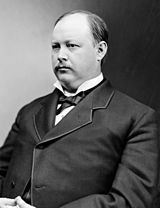November 6, 1894 1896 → 254 93 11 seats 1 seat | 124 seats 220 seats 130 127 9 1 | |
 | ||
Winner Thomas Brackett | ||
Elections to the United States House of Representatives in 1894 comprised a significant realigning election — a major Republican landslide that set the stage for the decisive election of 1896. The elections of members of the United States House of Representatives in 1894 came in the middle of President Grover Cleveland's second term. The nation was in its deepest economic depression ever following the Panic of 1893, so economic issues were at the forefront. In the spring, a major coal strike damaged the economy of the Midwest and Mid-Atlantic. It was accompanied by violence; the miners lost and many moved toward the Populist party. Immediately after the coal strike concluded, Eugene V. Debs led a nationwide railroad strike, called the Pullman Strike. It shut down the nation's transportation system west of Detroit for weeks, until President Cleveland's use of federal troops ended the strike. Debs went to prison (for disobeying a court order). Illinois's Governor John Peter Altgeld, a Democrat, broke bitterly with Cleveland.
Contents
The fragmented and disoriented Democratic Party was crushed everywhere outside the South, losing more than half its seats to the Republican Party. Even in the South, the Democrats lost seats to Republican-Populist electoral fusion in Alabama, Texas, Tennessee, and North Carolina. The Democrats ultimately lost 127 seats in the election while the Republicans gained 130 seats (after the resolution of several contested elections). This is the largest swing in the history of the House of Representatives, and also makes the 1894 election the single largest midterm election victory in the entire history of the United States. (A political party would not suffer triple-digit losses again until 1932.)
The main issues revolved around the severe economic depression, which the Republicans blamed on the conservative Bourbon Democrats led by Cleveland. Cleveland supporters lost heavily, weakening their hold on the party and setting the stage for an 1896 takeover by the silverist wing of the party. The Populist Party ran candidates in the South and Midwest, but generally lost ground, outside Alabama, North Carolina, Tennessee, and Texas where state-level fusion with the Republicans was successful despite Populist and Republican antagonism at the national level. The Democrats tried to raise a religious issue, claiming the GOP was in cahoots with the American Protective Association. The allegations seem to have fallen flat as Catholics moved toward the GOP.
Election summaries
One seat was added for the new State of Utah.
The previous election of 1892 saw 11 Populists and a Silver Party member win seats.
Early election dates
In 1894, three states, with 8 seats among them, held elections early:
Complete returns
South Carolina
In the 1st district, Murray successfully challenged Elliott's election and was awarded the seat on June 4, 1896.
The election in the 7th district was declared void on June 1, 1896 due to electoral fraud
Utah
This was Utah's first election for Representatives.
